Available with Spatial Analyst license.
A set of conceptual steps can be used to help you build a model. To understand the sequence of steps, you will work through a sample problem. As a town planner, you have been assigned the task of finding suitable locations for a new school. You can combine tools from the ArcGIS Spatial Analyst extension to help you identify the potential sites.
Step 1: State the problem
To solve a spatial problem, you should first state the problem you are trying to solve and the goal you are trying to achieve. Start with a concept of the intended output of the study to visualize the types of maps you want to produce.
Your problem is to find the best location for siting a new school. You will need to produce two maps. The first will identify the suitability of each location relative to one another, known as the suitability map. The second, which is derived from the suitability map, will identify the actual location to build the school, accounting for the functional needs of the school (size and desired shape). To create these two maps, you will produce a weighted suitability model.
To help you model your spatial problem, draw a diagram of the steps involved. Start with the statement of the problem. As you work through the problem, you will expand the diagram to show objectives, process models, and input datasets needed to reach your goal.
Step 2: Break down the problem
Once the problem is stated, break it down into smaller pieces until you know what steps are required to solve it. These steps are the objectives that you will solve.
When defining objectives, consider how you will measure them. How will you measure what is the best area for the new school? In this hypothetical school siting example, a driving factor is to minimize the cost of development. It would be cheaper to build on certain land-use types, such as areas that are currently open fields, as compared to areas that have already had some development. Another factor is terrain, since it is typically easier to build on flat areas than steep slopes. Since many of the families who have relocated to the town have young children, it is preferable to locate near recreational facilities. To distribute the resources throughout the town, it is important to locate away from existing schools. For the functional requirements of the school, the potential site needs to be large enough for the school and its grounds. There are obviously more objectives that could be included, such as cost for purchasing the land or locating in an area with the highest density of children of an appropriate age, but this model is simplified for the purpose of the example.
To meet these objectives, you want to know the following:
- Is the land use in these locations of a suitable type?
- Where are locations with relatively flat land?
- Are these locations close enough to recreation sites?
- Are they far enough away from existing schools?
Is the land use in these locations of a suitable type?
You need to decide what makes a suitable land-use type on which to build. This is a subjective process according to your problem. Here, agricultural land is considered the least costly to build on and, therefore, the most preferable. Barren land is next, and then scrub brush; forest; and last, existing built-up areas. There is no process model involved here, just an identification of the input land-use dataset and which land uses are most preferable to build on.
- Input dataset needed: Land use
Where are locations with relatively flat land?
To find areas of relatively flat land, you need to create a map displaying the slope of the land. The process model here involves calculating the slope of the land.
- Input dataset needed: Elevation
Are these locations close enough to recreation sites?
You know that it is preferable to locate the school close to recreational facilities, so you need to create a map displaying distances to recreation sites to potentially locate the school in areas that are close to them. The process model here involves calculating distances from recreation sites.
- Input dataset needed: Location of recreational facilities
Are they far enough away from existing schools?
You want to site the school away from existing schools to avoid encroaching on their catchment areas. So you need to create a map displaying the distance to schools. Here, the process model involves calculating the distance from existing schools.
- Input dataset needed: Location of existing schools
Step 3: Explore input datasets
Once you have broken down your problem into a series of objectives and process models and decided what datasets you will need, you should explore your input datasets to understand their content. This involves understanding which attributes within and between datasets are important for solving the problem and looking for trends in the data.
By exploring your data, you can often gain insights about the areas in which you want to locate the school, the weighting for input attributes, and alterations to your modeling process. You can see the locations of existing schools and recreation sites, and you can tell from the elevation dataset where the higher elevations are. The land-use dataset tells you what types of land use are in the area and where they are located in relation to the other datasets.
Step 4: Perform analysis
You have decided on your objectives, the elements and their interactions, the process models, and what input datasets you will need. You are now in the position to perform analysis.
Many tasks that can be solved by ArcGIS are discussed in the Esri Guide to GIS Analysis book, available through Esri Press.
The following is a general process diagram for this example of identifying the ideal location for a proposed new school. The accompanying text will go into more detail for each of the steps.
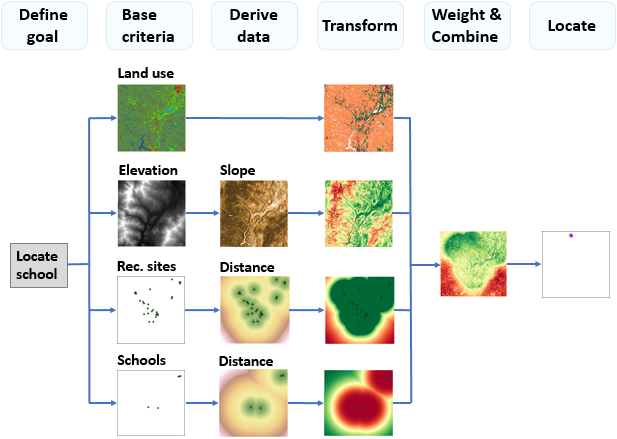
Create a suitability map
Creating a suitability map enables you to obtain a suitability value for every location on the map.
Once you have the necessary dataset layers in place (in this example, those are Land use, Slope, Distance to recreation sites, and Distance to schools) for your analysis, how do you combine them to create a single ranked map of potential areas to site the school? You need a way to compare the values between layers. You can do so by transforming the values within the different datasets onto a common scale.
Each location in each layer is ranked by how suitable it is as a location for a new school. For example, you might assign a value to each location in each layer on a scale of 1 to 10, with 10 being the best.
This is often referred to as a suitability scale. NoData can be used to mask off areas that should not be considered. Having all measures on the same numeric scale gives them equal importance in determining the most suitable locations. The model is initially constructed in this way. Then, while testing alternative scenarios, different weight factors can be applied to the layers to further explore the data and its relationships.
Create suitability scales
As is the case with this example, many of the measurement units for the suitability scales are synthetic. No matter what measurement units are used for the suitability scale, each is a ranked measure of suitability, or preference, from best to worst. The units should be based on something you can measure, such as distance to schools. In many cases, however, it is a subjective measure of how suitable a certain distance is from a school for locating another school.
There are natural measurement units that are commonly associated with some objectives. Cost is a good example but needs to be defined in sufficient detail. In a study of building suitability, an objective of low real estate cost would be measured on a scale of dollars. Be sure to adequately define the scale. For something as well understood as dollars, there are other variables, such as whether it's U.S. dollars, Australian dollars, or an exchange rate between monies.
Many scales are not linear relationships, although they are often presented that way to save time and money or because all options were not considered. For example, if assigning a scale to travel distance, traveling 1, 5, or 10 kilometers would not be ranked as a suitability of 10, 5, and 1 if you were walking. Some people may think that walking 5 kilometers is only two times as bad as 1 kilometer, while others may think it's 10 times as bad.
When you construct a suitability scale, work with experts to find the best and worst of a scenario and as many intermediate points as possible. Experts should be knowledgeable about the objective being studied. For example, it is more meaningful to ask commuters to rank their opinions on drive time desirability than to ask a city official when he thinks traffic is worst.
See GIS and Multicriteria Decision Analysis by Jacek Malczewski for more information on dealing with conflicting objectives and evaluation criteria.
Rank the inputs
Once your various inputs are prepared, they now need to be transformed to the common scale.
Rank the areas on suitable land-use types
To rank the map representing land-use types, use the Reclassify tool. As it is preferable to build on certain land-use types due to the costs involved, you need to decide how to rank the values.
Here you have to decide which land-use types are preferable. This is subjective depending on your study. The easiest way to decide what type of land is preferable for building on and what is not is to decide on the most preferable and the least preferable. Then, out of the land-use types left, again decide on the most and least preferable. Do this until you have put the land-use types in order of preference. Land uses of water and wetlands have been excluded from the analysis, as you cannot build on water and there are restrictions against building on wetlands. The illustration below shows how the land-use types have been ranked.
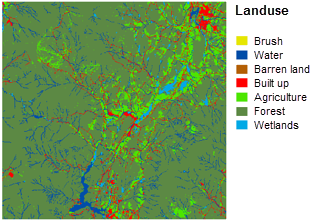
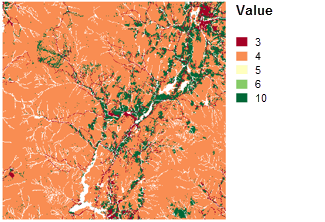
Rank the areas on relatively flat land
To avoid steep terrain and find areas that are relatively flat to build on, you need to know the slope of the land. The Slope tool will create such a map, identifying for each cell the maximum rate of change in value from each cell to its neighbors. The resulting raster records the slope as continuously changing floating-point values. Because the preference is considered to vary directly with changes in the slope value, the Rescale by Function tool will be used to rank this map, by applying the Linear function. Since it is preferable to locate on relatively flat areas, give a value of 1 to locations with steep slopes and 10 to locations with the shallow slopes. The values in between will be adjusted in a linear fashion, as the following illustration shows.
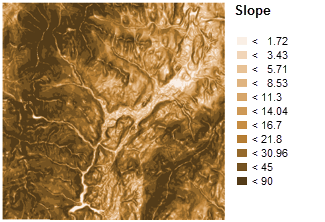
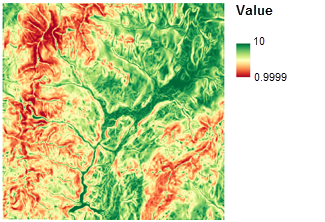
Rank the areas close to recreation sites
To site the school close to recreational facilities, you need to know the distance to them. The Distance Accumulation tool will create such a map, calculating the straight-line (Euclidean) distance from any location to the nearest recreation site. The result is a raster dataset in which every cell represents the distance to the nearest recreation site. Since the input values represent continuous distances, to rank this map, use the Rescale by Function tool. As it is much more preferable to locate closer to recreation sites, the MSSmall function is applied. This will assign much higher preference values to the locations closer to the recreation sites, with locations farther away being far less preferred. With each meter change in distance from the recreation sites, the preference continuously changes, as the following illustration shows.
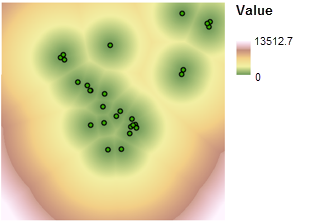
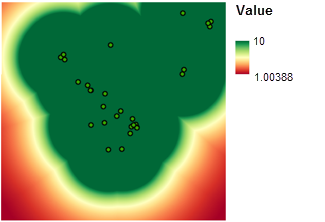
Rank the areas away from existing schools
To avoid the catchment areas of the other schools, you need to know the distance to them. The Distance Accumulation tool will create such a map, calculating the straight-line distance from any location to the nearest school. The result is a raster dataset in which every cell represents the distance to the nearest school. To rank this map, once again use the Rescale by Function tool. As it is preferable to locate away from existing schools, the Large function is used to give a value of 1 to distances closest to existing schools and a value of 10 to distances farthest away from existing schools. With the Large function, the preferences continuously increase with each meter the location is from the school, as the following illustration shows.
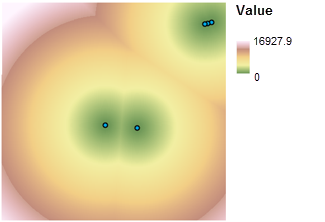
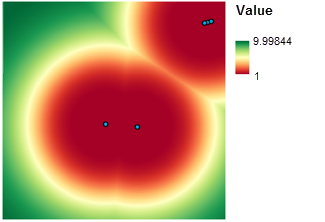
Combine the suitability maps
The last step in the suitability model is to combine the transformed outputs (the suitability maps) of land-use types, slope, distance to recreation sites, and distance to schools.
To account for the fact that some objectives have more importance in the suitability model, you can weight the datasets, giving those datasets that should have more importance in the model a higher percentage influence (weight) than the others. If all datasets are of equal importance, you can assign the same weight to each one.
In the example, you know from breaking down the problem that the most preferable objective to satisfy is to locate the school close to recreational facilities, and the next is to locate it away from existing schools. The following percentage influences will be assigned to the suitability maps. The values in parentheses are the percentage divided by 100 to normalize the values. This normalized value will be used as the multiplier for each suitability map.
Suitability percentages
| Suitability factor | Percent influence | Percentage normalized |
|---|---|---|
Ranked distance to recreation sites | 50% | (0.5) |
Ranked distance to schools | 25% | (0.25) |
Ranked slope | 12.5% | (0.125) |
Ranked land-use types | 12.5% | (0.125) |
The distance to the recreation sites suitability map has an influence of 50 percent (0.5) on the final result, and the distance to schools has an influence of 25 percent (0.25). Slope and land-use types both have a 12.5 percent (0.125) influence. Like assigning scales of suitability, assigning weights is a subjective process, depending on what objectives are most important to your study.
The final suitability map is produced by combining all the maps. Weights can be assigned at the same time as combining the suitability maps. The final suitability map for locating sites for the school is shown below. Most suitable locations are in the darkest green color. The least suitable locations are in red shades.
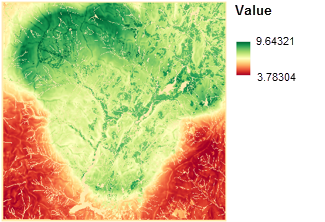
You can use Map algebra to weight and combine datasets. Alternatively, you can use the Weighted Overlay or Weighted Sum tool. If you use a tool in a model, you have the option of going back and easily altering weights (percent influence) and any scale values you may have set. Connecting geoprocessing tools inside a model means you only need to create the model once, then you can alter parameter values to experiment with different outcomes.
Locate the school
The final step to this modeling process is to actually locate the school. The final suitability surface ranks the attributes at each location relative to the land-use type, slope, distance from recreation sites, and distance from schools. However, the proposed school also has spatial requirements in which to efficiently function.
The best site for your school would be located on 150 contiguous acres of land, to accommodate the athletic fields. For building construction and maintenance efficiency, the configuration of the site should be relatively compact.
The Locate Regions tool will be used on the final suitability surface to find the best 150-acre site.
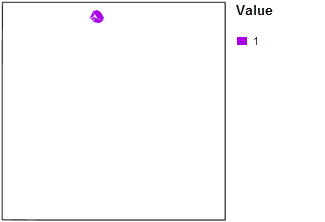
Compare the proposed site to the suitability map from the previous step.
Step 5: Verify the result
Once you have your result from any spatial analysis, you should verify that it is correct. If possible, this should be done by visiting the potential sites in the field. Often the result you achieve has not accounted for something important. For example, there may be a chicken farm upwind of the site that is producing foul odors, or by examining the town hall records you may discover a restriction on building on the desired land of which you were not aware. If either is the case, you will need to add this information to the analysis.
Step 6: Implement the result
The final step in the spatial model is to implement the result, which is to commence the planning and construction of the new school in the chosen location.
To learn more, see The general suitability modeling workflow in Spatial Analyst.
References
Malczewski, J. GIS and Multicriteria Decision Analysis. Wiley & Sons, 1999.